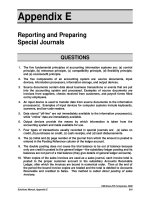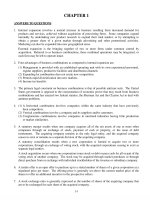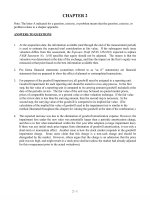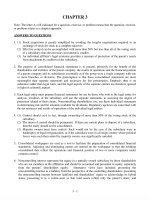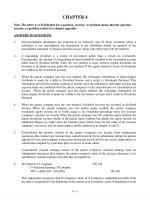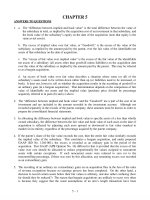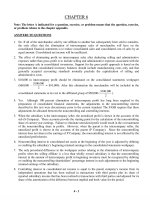Solution manual advanced accounting 4e jeter ch01
Bạn đang xem bản rút gọn của tài liệu. Xem và tải ngay bản đầy đủ của tài liệu tại đây (116.22 KB, 7 trang )
To download more slides, ebook, solutions and test bank, visit
CHAPTER 1
ANSWERS TO QUESTIONS
1. Internal expansion involves a normal increase in business resulting from increased demand for
products and services, achieved without acquisition of preexisting firms. Some companies expand
internally by undertaking new product research to expand their total market, or by attempting to
obtain a greater share of a given market through advertising and other promotional activities.
Marketing can also be expanded into new geographical areas.
External expansion is the bringing together of two or more firms under common control by
acquisition. Referred to as business combinations, these combined operations may be integrated, or
each firm may be left to operate intact.
2. Four advantages of business combinations as compared to internal expansion are:
(1) Management is provided with an established operating unit with its own experienced personnel,
regular suppliers, productive facilities and distribution channels.
(2) Expanding by combination does not create new competition.
(3) Permits rapid diversification into new markets.
(4) Income tax benefits.
3. The primary legal constraint on business combinations is that of possible antitrust suits. The United
States government is opposed to the concentration of economic power that may result from business
combinations and has enacted two federal statutes, the Sherman Act and the Clayton Act to deal with
antitrust problems.
4. (1) A horizontal combination involves companies within the same industry that have previously
been competitors.
(2) Vertical combinations involve a company and its suppliers and/or customers.
(3) Conglomerate combinations involve companies in unrelated industries having little production
or market similarities.
5. A statutory merger results when one company acquires all of the net assets of one or more other
companies through an exchange of stock, payment of cash or property, or the issue of debt
instruments. The acquiring company remains as the only legal entity, and the acquired company
ceases to exist or remains as a separate division of the acquiring company.
A statutory consolidation results when a new corporation is formed to acquire two or more
corporations, through an exchange of voting stock, with the acquired corporations ceasing to exist as
separate legal entities.
A stock acquisition occurs when one corporation issues stock or debt or pays cash for all or part of the
voting stock of another company. The stock may be acquired through market purchases or through
direct purchase from or exchange with individual stockholders of the investee or subsidiary company.
6. A tender offer is an open offer to purchase up to a stated number of shares of a given corporation at a
stipulated price per share. The offering price is generally set above the current market price of the
shares to offer an additional incentive to the prospective sellers.
7. A stock exchange ratio is generally expressed as the number of shares of the acquiring company that
are to be exchanged for each share of the acquired company.
1-1
To download more slides, ebook, solutions and test bank, visit
8. Defensive tactics include:
(1) Poison pill – when stock rights are issued to existing stockholders that enable them to purchase
additional shares at a price below market value, but exercisable only in the event of a potential
takeover. This tactic is effective in some cases.
(2) Greenmail – when the shares held by a would-be acquiring firm are purchased at an amount
substantially in excess of their fair value. The shares are then usually held in treasury. This tactic is
generally ineffective.
(3) White knight or white squire – when a third firm more acceptable to the target company
management is encouraged to acquire or merge with the target firm.
(4) Pac-man defense – when the target firm attempts an unfriendly takeover of the would-be
acquiring company.
(5) Selling the crown jewels – when the target firms sells valuable assets to others to make the firm
less attractive to an acquirer.
9. In an asset acquisition, the firm must acquire 100% of the assets of the other firm, while in a stock
acquisition, a firm may gain control by purchasing 50% or more of the voting stock. Also, in a stock
acquisition, formal negotiations with the target’s management can sometimes be avoided. Further, in
a stock acquisition, there might be advantages in keeping the firms as separate legal entities such as
for tax purposes.
10. Does the merger increase or decrease expected earnings performance of the acquiring institution?
From a financial and shareholder perspective, the price paid for a firm is hard to justify if earnings per
share declines. When this happens, the acquisition is considered dilutive. Conversely, if the earnings
per share increases as a result of the acquisition, it is referred to as an accretive acquisition.
11. Under the parent company concept, the writeup or writedown of the net assets of the subsidiary in
the consolidated financial statements is restricted to the amount by which the cost of the investment
is more or less than the book value of the net assets acquired. Noncontrolling interest in net assets is
unaffected by such writeups or writedowns.
The economic unit concept supports the writeup or writedown of the net assets of the subsidiary by
an amount equal to the entire difference between the fair value and the book value of the net assets
on the date of acquisition. In this case, noncontrolling interest in consolidated net assets is adjusted
for its share of the writeup or writedown of the net assets of the subsidiary.
12. a) Under the parent company concept, noncontrolling interest is considered a liability of the
consolidated entity whereas under the economic unit concept, noncontrolling interest is
considered a separate equity interest in consolidated net assets.
b) The parent company concept supports partial elimination of intercompany profit whereas the
economic unit concept supports 100 percent elimination of intercompany profit.
c) The parent company concept supports valuation of subsidiary net assets in the consolidated
financial statements at book value plus an amount equal to the parent company’s percentage
interest in the difference between fair value and book value. The economic unit concept
supports valuation of subsidiary net assets in the consolidated financial statements at their fair
value on the date of acquisition without regard to the parent company’s percentage ownership
interest.
d) Under the parent company concept, consolidated net income measures the interest of the
shareholders of the parent company in the operating results of the consolidated entity. Under the
1-2
To download more slides, ebook, solutions and test bank, visit
economic unit concept, consolidated net income measures the operating results of the
consolidated entity which is then allocated between the controlling and noncontrolling interests.
13. The implied fair value based on the price may not be relevant or reliable since the price paid is a
negotiated price which may be impacted by considerations other than or in addition to the fair value
of the net assets of the acquired company. There may be practical difficulties in determining the
fair value of the consideration given and in allocating the total implied fair value to specific assets
and liabilities.
In the case of a less than wholly owned company, valuation of net assets at implied fair value
violates the cost principle of conventional accounting and results in the reporting of subsidiary
assets and liabilities using a different valuation procedure than that used to report the assets and
liabilities of the parent company.
14. The economic entity is more consistent with the principles addressed in the FASB’s conceptual
framework. It is an integral part of the FASB’s conceptual framework and is named specifically in
SFAC No. 5 as one of the basic assumptions in accounting. The economic entity assumption views
economic activity as being related to a particular unit of accountability, and the standard indicates
that a parent and its subsidiaries represent one economic entity even though they may include
several legal entities.
15. The FASB’s conceptual framework provides the guidance for new standards. The quality of
comparability was very much at stake in FASB’s decision in 2001 to eliminate the pooling of
interests method for business combinations. This method was also argued to violate the historical
cost principle as it essentially ignored the value of the consideration (stock) issued for the
acquisition of another company.
The issue of consistency plays a role in the recent proposal to shift from the parent concept to the
economic entity concept, as the former method valued a portion (the noncontrolling interest) of a
given asset at prior book values and another portion (the controlling interest) of that same asset at
exchange-date market value.
16. Comprehensive income is a broader concept, and it includes some gains and losses explicitly stated
by FASB to bypass earnings. The examples of such gains that bypass earnings are some changes in
market values of investments, some foreign currency translation adjustments and certain gains and
losses, related to minimum pension liability.
In the absence of gains or losses designated to bypass earnings, earnings and comprehensive
income are the same.
1-3
To download more slides, ebook, solutions and test bank, visit
ANSWERS TO BUSINESS ETHICS CASE
1. The third item will lead to the reduction of net income of the acquired company before
acquisition, and will increase the reported net income of the combined company subsequent to
acquisition. The accelerated payment of liabilities should not have an effect on net income in
current or future years, nor should the delaying of the collection of revenues (assuming those
revenues have already been recorded).
2. The first two items will decrease cash from operations prior to acquisition and will increase cash
from operations subsequent to acquisition. The third item will not affect cash from operations.
3. As the manager of the acquired company I would want to make it clear that my future
performance (if I stay on with the consolidated company) should not be evaluated based upon a
future decline that is perceived rather than real. Further, I would express a concern that
shareholders and other users might view such accounting maneuvers as sketchy.
4.
a) Earnings manipulation may be regarded as unethical behavior regardless of which side of
the acquirer/acquiree equation you’re on. The benefits that you stand to reap may differ,
and thus your potential liability may vary. But the ethics are essentially the same.
Ultimately the company may be one unified whole as well, and the users that are affected
by any kind of distorted information may view any participant in an unsavory light.
b) See answer to (a).
1-4
To download more slides, ebook, solutions and test bank, visit
ANSWERS TO EXERCISES
Exercise 1-1
Part A Normal earnings for similar firms = ($15,000,000 - $8,800,000) x 15% = $930,000
Expected earnings of target:
Pretax income of Condominiums, Inc., 2008
Subtract: Additional depreciation on building ($960,000
Target’s adjusted earnings, 2008
$1,200,000
(288,000)
30%)
912,000
Pretax income of Condominiums, Inc., 2009
Subtract: Additional depreciation on building
Target’s adjusted earnings, 2009
$1,500,000
(288,000)
1,212,000
Pretax income of Condominiums, Inc., 2010
Add: Extraordinary loss
Subtract: Additional depreciation on building
Target’s adjusted earnings, 2010
Target’s three year total adjusted earnings
Target’s three year average adjusted earnings ($3,086,000
$950,000
300,000
(288,000)
3)
962,000
3,086,000
1,028,667
Excess earnings of target = $1,028,667 - $930,000 = $98,667 per year
Present value of excess earnings (perpetuity) at 25%:
$98 ,667
= $394,668 (Estimated Goodwill)
25 %
Implied offering price = $15,000,000 – $8,800,000 + $394,668 = $6,594,668.
Part B Excess earnings of target (same as in Part A) = $98,667
Present value of excess earnings (ordinary annuity) for three years at 15%:
$98,667 2.28323 = $225,279
Implied offering price = $15,000,000 – $8,800,000 + $225,279 = $6,425,279.
Note: The sales commissions and depreciation on equipment are expected to continue at the
same rate, and thus do not necessitate adjustments.
1-5
To download more slides, ebook, solutions and test bank, visit
Exercise 1-2
Part A Cumulative 5 years net cash earnings
Add nonrecurring losses
Subtract extraordinary gains
Five-years adjusted cash earnings
$831,000
Average annual adjusted cash earnings
5
$850,000
48,000
(67,000)
$831,000
$166,200
(a) Estimated purchase price = present value of ordinary annuity of $166,200 (n=5, rate= 15%)
$166,200 3.35216 =
$557,129
(b) Less: Market value of identifiable assets of Beta
Less: Liabilities of Beta
Market value of net identifiable assets
Implied value of goodwill of Beta
$750,000
320,000
Part B Actual purchase price
Market value of identifiable net assets
Goodwill purchased
430,000
$127,129
$625,000
430,000
$195,000
Exercise 1-3
Part A
Normal earnings for similar firms (based on tangible assets only) = $1,000,000 x 12% = $120,000
Excess earnings = $150,000 – $120,000 = $30,000
(1)
Goodwill based on five years excess earnings undiscounted.
Goodwill = ($30,000)(5 years) = $150,000
(2)
Goodwill based on five years discounted excess earnings
Goodwill = ($30,000)(3.6048) = $108,144
(present value of an annuity factor for n=5, I=12% is 3.6048)
(3)
Goodwill based on a perpetuity
Goodwill = ($30,000)/.20 = $150,000
Part B
The second alternative is the strongest theoretically if five years is a reasonable representation of
the excess earnings duration. It considers the time value of money and assigns a finite life.
Alternative three also considers the time value of money but fails to assess a duration period for
the excess earnings. Alternative one fails to account for the time value of money. Interestingly,
alternatives one and three yield the same goodwill estimation and it might be noted that the
assumption of an infinite life is not as absurd as it might sound since the present value becomes
quite small beyond some horizon.
Part C
Goodwill = [Cost less (fair value of assets less the fair value of liabilities)],
1-6
To download more slides, ebook, solutions and test bank, visit
Or, Cost less fair value of net assets
Goodwill = ($800,000 – ($1,000,000 - $400,000)) = $200,000
1-7


